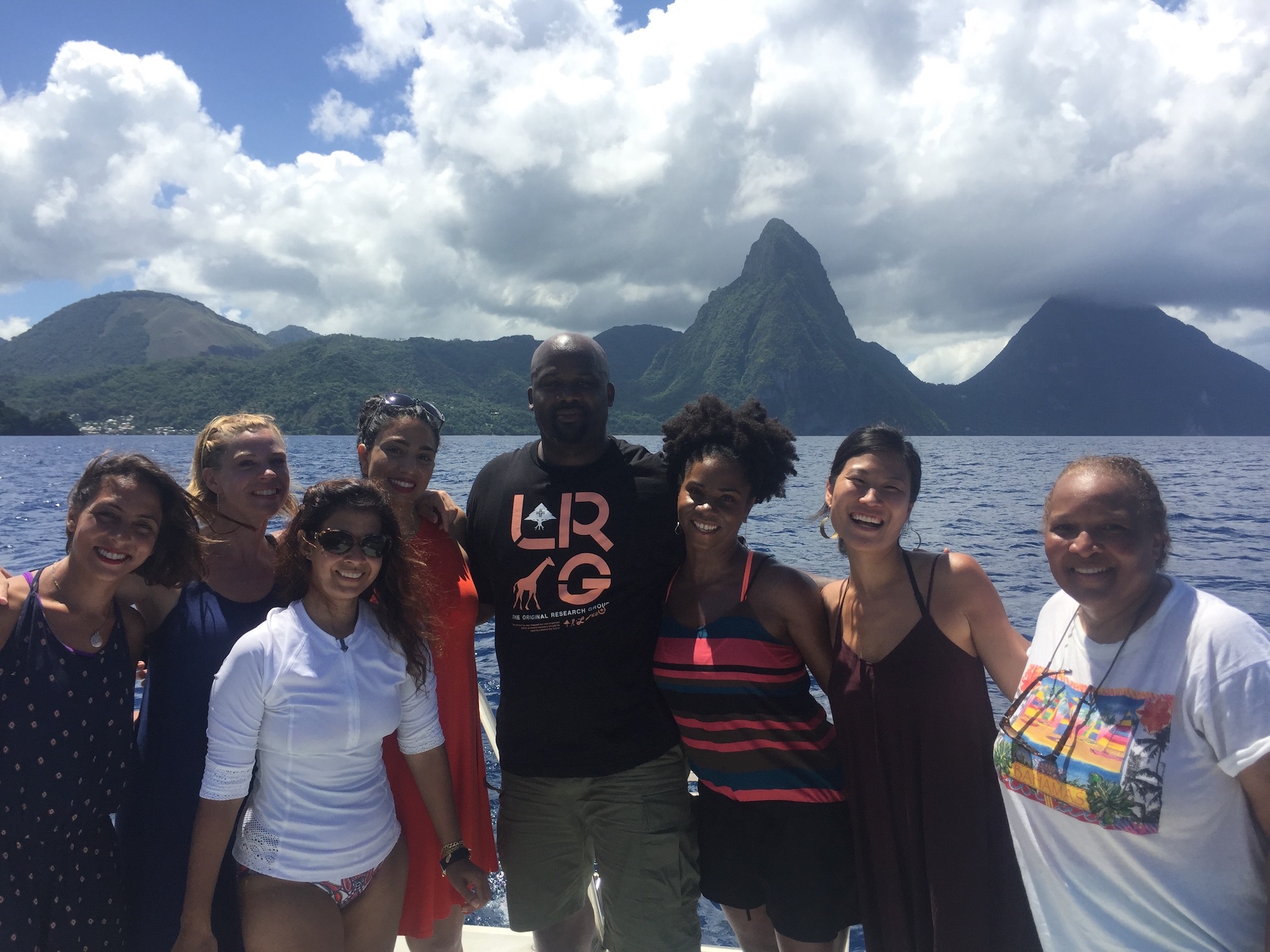Labor Day Weekend 2017 marked my first experience flying solo as a facilitator of a destination yoga retreat. I had the privilege of teaching yoga and mindfulness to some amazing human beings against the backdrop of St. Lucia at the lovely Ti Kaye Resort and Spa. Knowing how exhausting it can be to hold space for large groups from my experiences as a co-retreat facilitator or solo teacher trainer, Ti Kaye and I made the choice to keep the number of participants relatively small for this first retreat. I also kept the content to leisure ratio leaning heavier on the leisure side. My overall goal was to strike a balance between group instruction and activities, relaxation, time for personal reflection, and cultural and geographical exploration of the picturesque, volcanic Caribbean island. The theme of this retreat was self-care and developing personal practice toolkits rooted in the yoga and mindfulness traditions as preparation for returning to our careers, a busier fall season, the overwhelming stress of these social and political times, and life in general.
Co-Creating Community
We opened the extended weekend together with a collective reflection on what it means to join in community with people you have never met from diverse backgrounds. We discussed in advance the inevitability that “stuff would come up” as it always does in community because it is hard to coexist in relationship, even withpeople you know and love. We carved out the time to choose as a community how we would be and act under such potentially challenging circumstances. Doing so was in effect a way to connect us to ourselves as agents of our experience and to our personal and collective power. The overall heightened state of fear, anxiety, hate, shame, guilt, repression, jealousy and resentment presenting itself due to the present state of American socio-economics and politics makes clear that as individuals and as a national community, we might all benefit from exploring methods to access the power we have to create the world of our heart’s desire; a world we might all live and thrive in.
So often yoga teachers teach yoga as if the classroom is a vacuum. This drives me a bit nuts, honestly. I can count on two hands in twenty years (and at least 3100 yoga classes) the number of times a yoga teacher used her/his public class as an opportunity to make a direct connection between the release or resistance of tension and suffering on the yoga mat to what happens when suffering is released or resisted when “live and in technicolor” right outside the yoga studio or on the news that night. Yet for me, this is the entire point and purpose of practicing yoga: to access tools that support our ability to remain in the present time, at once thoughtful, empathetic, kind and powerful, despite the quality of circumstances. Practicing yoga “off the mat” means remaining connected to self and community as resources, particularly when life’s circumstances seem flung out of orbit and emotions run high. If this isn’t the golden ticket opportunity of yoga, then it baffles me as to why so many people do it. To feel good? What’s the point of merely “feeling good” if it only lasts for the 60 minutes you’re on the mat, then disappears once you step outside the classroom door? Yoga’s potential to cultivate the capacity within us to create a true home for ourselves is why I teach. And it’s definitely why I brought my participants together on retreat in St. Lucia: to practice co-creating the community together that reflects who we truly are.
Diversity of Perspectives Enriches Our Lives
The diverse spectrum of racial, ethnic, cultural, regional, physical and economic backgrounds and experiences and ages that were reflected on this retreat made Farewell to Summer in St. Lucia a soul-enriching experience. African Americans were present, as were Caribbean Americans, and Asian Americans, Africans, and one European American. One of my primary goals as a yoga teacher of color is to create spaces were diverse populations of yoga practitioners can feel safe, see themselves and their life experiences reflected in their teacher, and know that even their differences will be seen and honored. The professions of my participants were also diverse and included a surgeon, career educators, social justice activists, a FEMA rep (perfectly timed with Hurricane Irma a mere 400 miles away), an international finance expert, a former department of justice employee, lawyers, an actor/film-maker and producer, an occupational therapist, and of course a an actor and yoga teacher.
Most remarkable were the unforgettable conversations that we had about politics, white supremacy, the heart of democracy, unpacking our core emotional wounds, resources, both scarce and abundant, climate change, gender identity and construction, how to act mindfully in the face of the ruptures being created by our current presidential administration, hurricanes and FEMA, you name it. To look at this retreat group in an image and be a fly on the wall at mealtime would offer measurable evidence that I am realizing my
mission around this healing and unifying work of yoga. The best part of these discussions was that they happened within the context of honoring the full spectrum of diverse experience by way of our community agreements. There were times when I wondered how a group with this variety of skills and expertise might survive a disaster, and in my imagination I could only see how well we would fare if we pooled our resources and honored our community agreements even then. A broad spectrum of experience and perspective supported my mutual respect yields a greater likelihood of being successful in a dire situation. Similarly, democracy shows that the potential to learn, grow, and make progress as a collective exists only when we can successfully hold the tension of our differences when social needs are great, contrasting or problematic. Though I wish I saw more of this in Washington D.C. and across this nation right now, I still feel full, inspired and truly contributed to by each participants’ ability to demonstrate grace and patience with perspectives that may have been different than her/his own on this retreat.
Acknowledging Ancestral Sacrifice & Honoring the Land and People Who Open Their Home to Us
Fundamental to my personal practice is a ritual that intentionally opens me to the role my ancestors have played in ensuring the blessings that I can claim today. To honor and make progress on the arch that is history, it is critical that I see my experience connected to theirs and those generations who will come after me. In the case of traveling to a destination that was not our home, it would cause harm not to honor the Amerindians who sacrificed their lives and entire way of life when St. Lucia was colonized and brutally fought over by the French and British at least fourteen times in the last 300 years. The people of St. Lucia today, kind and generous as they are with their land, do not consistently reap deep economic benefits from their own geographic bounty. When walking through Castries, the capital of St. Lucia, and through the countryside, the most beautiful homes or thriving businesses did not appear to be owned by locals, but rather foreigners, most of whom had lighter skin. How often on vacation do we ignore the obvious fact that those whose land we are in are rarely able to partake in the leisure we do in their own land? The ever-present evidence of the white supremacist paradigm and the legacy of white-owned slave plantations was clear, and this retreat featured many opportunities to support the locals directly through excursions and abundant gratuity. But in fairness, we could not have done enough to rebalance the scales of economic inequity that remain entrenched in the systemic organization of Western society. This fact remains difficult to sit with. We still have so much work to do.
A Model for Green Living
One final feature of Ti Kaye Resort that I deeply appreciated was their environmentally conscious business practices as a model for sustainable living: from green construction and interior design, energy efficient appliances, to locally sourced produce, poultry, meats and seafood, an on site desalination plant and glass bottle use, composting and recycling systems, and no plastic, styrofoam or paper product waste. Recognizing that the Earth is a living and vulnerable entity, and that such efforts to preserve it as seen in action at Ti Kaye, provided important education and acknowledgment that the sustainability of our lives and all living beings on Earth is dependent on sustaining our planetary environment. Period.

